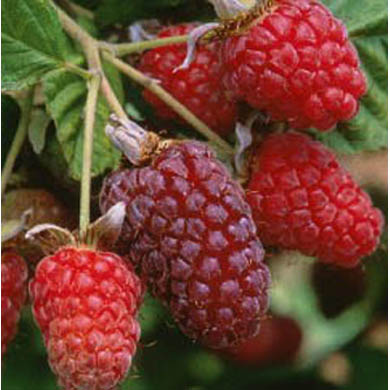Loganberry - Planting and Care Guide

The Loganberry is, perhaps, the supreme bramble type of berry, as it is ideal for stewing, jam- and jelly-making, bottling, canning, juice extraction and wine making. The berries can also be eaten as dessert when fully ripe, but may be too tart for some palates. The Loganberry produces vigorous, prickly canes carrying 3- to 5-lobed leaves. As flowering is late, the plants may be grown in low-lying situations; spring frosts rarely damage the blossom, though severe winters may affect the canes. Loganberries are self-compatible (self-fertile) and yield heavy crops of blunt, firm, very juicy, deep red berries of a rich flavour, from August to September. The yield may be sustained for 15 years or more. The berries do not plug, so are picked complete with core. Picking is best done when the berries are quite dry. Heavy, rather than chalky and light and dry, soils are preferred-chalky soils induce iron and manganese deficiencies. Well-drained loams and brick earths are ideal. Loganberries love rich soil and respond to generous manuring. Nitrogen is the most important plant food requirement. A sunny and open but sheltered site is best with protection from northeast winds. The rows should run north south.
Propagation is usually by tip layering between June and mid-August. The tips of young canes are pegged down 6-8cm (2-5 in) deep (or weighted with a flat stone), into small pots filled with rooting compost and sunk in the ground. The young plants are severed from the parent canes when well rooted in the following February.
Alternatively, leaf bud cuttings are rooted 6cm (3in) apart in a bed of sandy soil in a closed and shaded garden frame in July or August. Each cutting consists of a leaf and bud with a 2.5cm (1in) length of cane bark devoid of pith. Roots are produced in three to four weeks; the young plants are hardened off a month later and transplanted the following spring.
Rooted tips or cuttings are planted 2-3m (6-10ft) apart in February or March against fences, north or east walls, and up arches. Post and wire supports with wires at 0.6, 1.2 and 2m (2, 4 and 6ft) from soil level are used on open sites. Shorten the young plants to 23cm (8in) after planting, to encourage the production of strong new shoots on which fruit will be borne the following year.
To reduce disease infection from the older canes, the young canes are trained fan-wise on the opposite side from the old canes. The two ages of cane occupy alternate sides annually. Ten to 12 fruiting canes are retained per plant. Fruiting is on one-year-old canes, which are cut down to ground level in October after fruit harvest.

